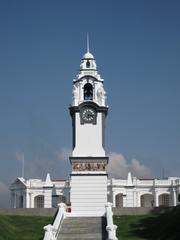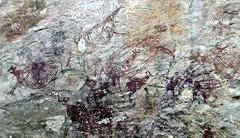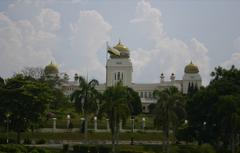Visiting Hours, Tickets, and Historical Insights of Lebuhraya Istana, Ulu Kinta, Malaysia
Date: 24/07/2024
Introduction
Lebuhraya Istana, situated in the historically rich region of Ulu Kinta, Malaysia, offers a deep dive into the country’s past. Visitors can explore a landscape shaped by its early settlement and the booming tin mining industry of the 18th century. The Kinta Valley, where Lebuhraya Istana is located, was once one of the world’s most productive tin mining regions, attracting a diverse influx of immigrants and transforming the local economy (Wikipedia). This guide provides an overview of Lebuhraya Istana, covering its historical background, key attractions, visitor information, and ongoing preservation efforts. Whether you’re a history enthusiast, a cultural explorer, or simply looking for a memorable travel experience, this guide will equip you with everything you need to know for your visit to this remarkable site.
Table of Contents
- [Introduction](#introductionintroduction)
- [Historical Background](#historical-backgroundhistorical-background)
- [Early Settlement and Tin Mining](#early-settlement-and-tin-miningearly-settlement-and-tin-mining)
- [Colonial Influence and Infrastructure Development](#colonial-influence-and-infrastructure-developmentcolonial-influence-and-infrastructure-development)
- [Significance of Lebuhraya Istana](#significance-of-lebuhraya-istanasignificance-of-lebuhraya-istana)
- [Economic Impact](#economic-impacteconomic-impact)
- [Cultural and Heritage Significance](#cultural-and-heritage-significancecultural-and-heritage-significance)
- [Visitor Tips for Exploring Lebuhraya Istana](#visitor-tips-for-exploring-lebuhraya-istanavisitor-tips-for-exploring-lebuhraya-istana)
- [Key Attractions](#key-attractionskey-attractions)
- [Practical Information](#practical-informationpractical-information)
- [Preservation Efforts and Future Prospects](#preservation-efforts-and-future-prospectspreservation-efforts-and-future-prospects)
- [Heritage Conservation](#heritage-conservationheritage-conservation)
- [Sustainable Tourism](#sustainable-tourismsustainable-tourism)
- [Frequently Asked Questions](#frequently-asked-questionsfrequently-asked-questions)
- [Call to Action](#call-to-actioncall-to-action)
- [Visuals and Media](#visuals-and-mediavisuals-and-media)
- [Internal and External Links](#internal-and-external-linksinternal-and-external-links)
- [Conclusion](#conclusionconclusion)
Historical Background
Early Settlement and Tin Mining
Lebuhraya Istana, located in Ulu Kinta, Malaysia, is part of the historically rich Kinta Valley. The valley has been significant since ancient times due to its abundant tin deposits. Initially inhabited by the ancestors of the Orang Asli, the region’s indigenous people, prehistoric remains like the Tambun rock art indicate a long-standing human presence (Wikipedia).
The discovery of substantial tin deposits in the 18th century marked a significant era. The Kinta Valley became one of the world’s most productive tin mining regions, attracting a diverse influx of immigrants, especially from China, who sought fortunes in the lucrative mining trade (Wikipedia). The introduction of dredging in 1913 by Malayan Tin Dredging Ltd. revolutionized the industry, making it the largest tin dredging company globally (Wikipedia).
Colonial Influence and Infrastructure Development
The colonial era brought significant changes to the Kinta Valley. Recognizing the economic potential of the tin mines, the British developed infrastructure to support the industry. A railway line linking Ipoh and other towns in the Kinta District was completed in 1909, primarily to transport tin ore (Wikipedia). However, the tracks were dismantled by the Japanese during World War II and were never rebuilt.
The colonial period also saw the establishment of various settlements to support the mining industry. These settlements, including Batu Gajah, Chemor, Gopeng, Kampar, Menglembu, and Papan, played crucial roles in the region’s development. The landscape modifications due to mining activities are still evident today, forming a significant part of the cultural landscape of the Kinta Valley (Semantic Scholar).
Significance of Lebuhraya Istana
Economic Impact
The economic significance of Lebuhraya Istana and the broader Kinta Valley cannot be overstated. The tin mining industry was the backbone of the region’s economy for many years. At its peak, the Kinta Valley was one of the world’s leading tin producers, significantly contributing to Malaysia’s economy. The wealth generated from tin mining led to infrastructure development, including roads, railways, and public buildings, which facilitated further economic growth (Wikipedia).
Despite the decline of the tin industry after World War II and the collapse of the international tin market in 1985, the legacy of tin mining continues to influence the region’s economy. Today, the Kinta Valley is recognized for its historical and cultural significance, attracting tourists and researchers interested in its rich mining heritage (Semantic Scholar).
Cultural and Heritage Significance
Lebuhraya Istana and the Kinta Valley hold immense cultural and heritage significance. The region’s history of tin mining has left a lasting impact on its cultural landscape. The mining operations led to the establishment of various towns and settlements, each with its unique history and cultural heritage. The remnants of mining activities, including dredge ponds, mining dams, and old mining equipment, are still visible today, serving as a testament to the region’s rich mining history (Semantic Scholar).
The Kinta Valley was declared Malaysia’s second national geopark in 2018, recognizing its geological, historical, and cultural significance. This designation aims to preserve the region’s unique heritage while promoting sustainable tourism and education (Wikipedia).
Visitor Tips for Exploring Lebuhraya Istana
Key Attractions
Visitors to Lebuhraya Istana and the Kinta Valley can explore several key attractions highlighting the region’s historical and cultural significance. One must-visit site is the last surviving tin dredge, located at Batu Gajah along Jalan Tanjung Tualang. This dredge, belonging to Southern Malaya Tin Dredging, offers a glimpse into the technological advancements that revolutionized the tin mining industry (Wikipedia).
Another significant site is the Tambun rock art, located near Ipoh. This rock art features ancient drawings believed to be thousands of years old, providing insights into the prehistoric inhabitants of the region (Wikipedia).
Practical Information
When planning a visit to Lebuhraya Istana and the Kinta Valley, consider practical information to ensure a memorable experience. The region is accessible by road, with Ipoh serving as the central hub. Visitors can reach Ipoh by car or bus from major cities such as Kuala Lumpur. The best time to visit is during the dry season, from May to September, when the weather is more favorable for outdoor activities.
For those interested in exploring the region’s mining heritage, guided tours are available. These tours provide in-depth information about the history and significance of the mining industry in the Kinta Valley. Additionally, several museums and heritage centers in the region offer exhibits and displays related to the tin mining era.
Preservation Efforts and Future Prospects
Heritage Conservation
Preserving the cultural and historical heritage of Lebuhraya Istana and the Kinta Valley is of paramount importance. The Perak State Structure Plan 2020 emphasizes the need to integrate the significance of the region’s cultural landscape with planning agendas for the Kinta District and Kampar District. This approach aims to protect the former mining landscape while accommodating metropolitan development expansion (Semantic Scholar).
Efforts are also being made to preserve the remaining mining structures and equipment. For instance, the contractor responsible for dismantling the old mining pipeline generously donated two 30-meter-long pipelines to the Perak State Government, recognizing their heritage significance (Semantic Scholar).
Sustainable Tourism
Promoting sustainable tourism is crucial for the future of Lebuhraya Istana and the Kinta Valley. By highlighting the region’s unique heritage and natural beauty, sustainable tourism can generate economic benefits while ensuring the preservation of its cultural and historical assets. The designation of the Kinta Valley as a national geopark is a step in this direction, encouraging responsible tourism practices and environmental conservation (Wikipedia).
Frequently Asked Questions
Q: What are the visiting hours for Lebuhraya Istana? A: The visiting hours for Lebuhraya Istana are typically from 9 AM to 5 PM, but it is advisable to check the official website or contact local authorities for the most updated information.
Q: Is there an entrance fee for Lebuhraya Istana? A: There may be a nominal entrance fee for certain attractions within Lebuhraya Istana. It is best to check specific sites or guided tour packages for detailed pricing.
Q: What nearby attractions can I visit? A: Nearby attractions include the Tambun rock art, the last surviving tin dredge at Batu Gajah, and several museums and heritage centers in Ipoh and surrounding towns. These sites provide comprehensive insights into the region’s rich history and cultural heritage.
Q: Are there guided tours available? A: Yes, guided tours are available and highly recommended for those interested in the historical and cultural significance of the region. These tours offer in-depth knowledge and a more enriching experience.
Call to Action
Ready to explore the rich history and cultural heritage of Lebuhraya Istana and the Kinta Valley? Plan your visit today, and don’t forget to check out our other related posts for more travel inspiration. Follow us on social media for the latest updates and travel tips!
Visuals and Media
(Include high-quality images or videos of Lebuhraya Istana and the Kinta Valley. Ensure these visuals are optimized for the web with correct sizing and alt tags using relevant keywords.)
Internal and External Links
Conclusion
Visiting Lebuhraya Istana in Ulu Kinta, Malaysia, offers a unique opportunity to explore a region steeped in historical and cultural significance. From its early days as a tin mining powerhouse to its present-day status as a national geopark, the Kinta Valley tells a compelling story of economic transformation and cultural heritage. Key attractions such as the last surviving tin dredge, the Tambun rock art, and various colonial-era settlements provide a vivid glimpse into the past. Additionally, ongoing preservation efforts and the promotion of sustainable tourism ensure that this rich heritage is protected for future generations (Wikipedia, Semantic Scholar). By following the tips and information provided in this guide, visitors can enjoy a safe, informative, and enriching experience. Ready to explore the rich history and cultural heritage of Lebuhraya Istana and the Kinta Valley? Plan your visit today, and don’t forget to check out our other related posts for more travel inspiration. Follow us on social media for the latest updates and travel tips!
References
- Wikipedia. (n.d.). Kinta Valley. Retrieved July 24, 2024, from https://en.wikipedia.org/wiki/Kinta_Valley
- Wikipedia. (n.d.). Kinta District. Retrieved July 24, 2024, from https://en.wikipedia.org/wiki/Kinta_District
- Semantic Scholar. (n.d.). The Cultural Landscape of the Kinta Valley. Retrieved July 24, 2024, from https://pdfs.semanticscholar.org/0bd1/2ae83c1e5d0c3fb9a4bb0a99ad393dc735a3.pdf
- Lebuhraya Istana Official Site. (n.d.). Retrieved July 24, 2024, from https://www.lebuhrayaistana.com
- Travels with Sun. (n.d.). Ipoh Old Town. Retrieved July 24, 2024, from https://www.travelswithsun.com/ipoh-old-town/
- Travel with Lens. (n.d.). Best Restaurants in Ipoh. Retrieved July 24, 2024, from https://travelwithlens.com/best-restaurants-in-ipoh/




